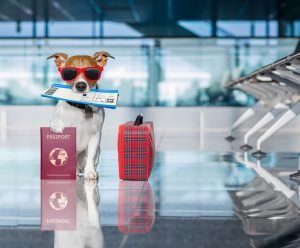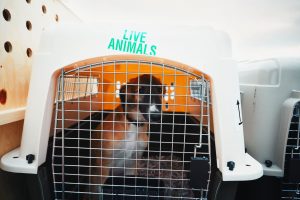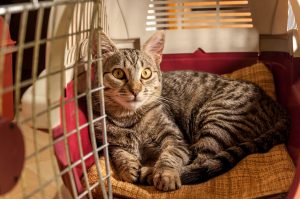Most people would love to take their pets with them on family trips, and last time, we looked at tips on going on road trips with your four-legged family members.
However, flying with pets is something that most people tend to avoid. It is something that is seen as full of hassles, and as being uncomfortable for the animal. But this doesn’t have to be the case. Here are a few tips for flying with your pet:

1. Are they fit to fly?
Not all pets are suited to travel by air. Things to consider are your pet’s temperament, any physical impairments/illnesses; if they are very young, or very old; and the breed of the animal. Make sure to visit your vet for a check-up to see if they are suited for air travel, and to get up-to-date on their vaccines.
2. Do your research
Before you book the flight, check the pet policies of the airline you’re flying on, and especially note the following – Do they allow cats or small dogs in the cabin? What restrictions do they have on transporting your pet in the cargo hold? Do they have any special vaccine requirements? What is their history of transporting animals?

3. Which flights to choose
Try to book a flight during non-peak times, so that there is likely to be fewer passengers and more room. Also, always book direct flights, as changing planes might cause unnecessary stress, especially if the layover is too short for a walk and a bathroom break. Do not feed your pet for four to six hours before you fly.
4. Your pet needs travel papers too
Dog, cats, ferrets, and other common pets require a pet passport to travel internationally or flying domestically. To get this pet passport, they need to be certified by a vet that they are up-to-date on their rabies vaccination, and also need to be fitted with an identifying microchip or tattoo.

5. Get a suitable carrier
Carriers can be found in both hard and soft-sided variations. Soft-sided carriers are typically used for carry-on pets, while the larger hard-sided ones are used in the hold. The carrier should allow your pet to stand up, turn around, and lie down comfortably. Give them a few weeks before travel to get comfortable with the new travel carrier, and to ensure that it has proper ventilation. While airlines may have different restrictions on dimensions, it is necessary that you provide food and water dishes, ‘Live Animal’ stickers, upright arrows and bedding for the carrier. Also, try to include a favorite toy with your scent on it.
6. Always use the proper collar and ID
Attach your contact information to both your pet’s collar and their carrier. This should include a permanent ID with your name, phone number, address, as well as a temporary ID with your destination, destination address, and a contact person there. It’s also good to give the information of a friend or family member at home.

7. Make sure to travel on the same flight
Always travel on the same flight as your pet, if you’re not carrying them into the cabin with you. Also, ask to watch them be loaded and unloaded to ensure their comfort.
8. Exercise on a leash
While most airports do not allow pets to be freed past security check, some do have designated areas for them to be exercised and relieve themselves. Carry a leash with you so that you can make use of these facilities. However, before you fly, play with your cat or walk your dog so that they are tired and more likely to sleep on the flight.

9. Do NOT tranquilize or sedate your pet
Do not give your pet tranquilizers or sedatives for air travel, unless your vet specifically prescribes this. Altitude can have an adverse effect with these medications, and many airlines no longer accept sedated animals.
10. Carry a photo
Apart from the pet passport, carry a current photo of your pet so that others can help you find it if it gets separated from you.
11. When you arrive
When you reach your destination, open the travel carrier as soon as you can and check that your pet is OK. If anything seems wrong, take them to a vet immediately.


